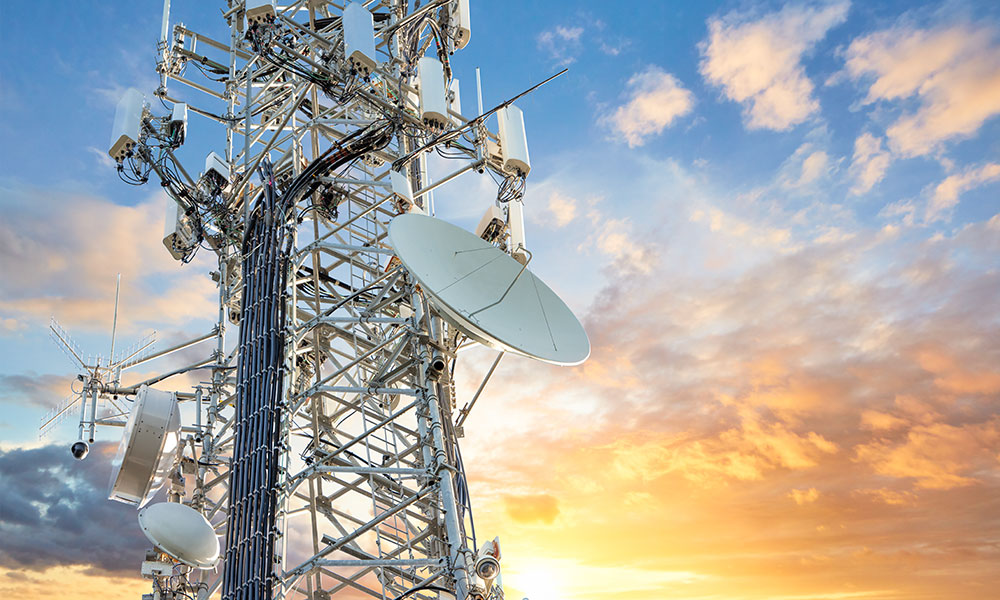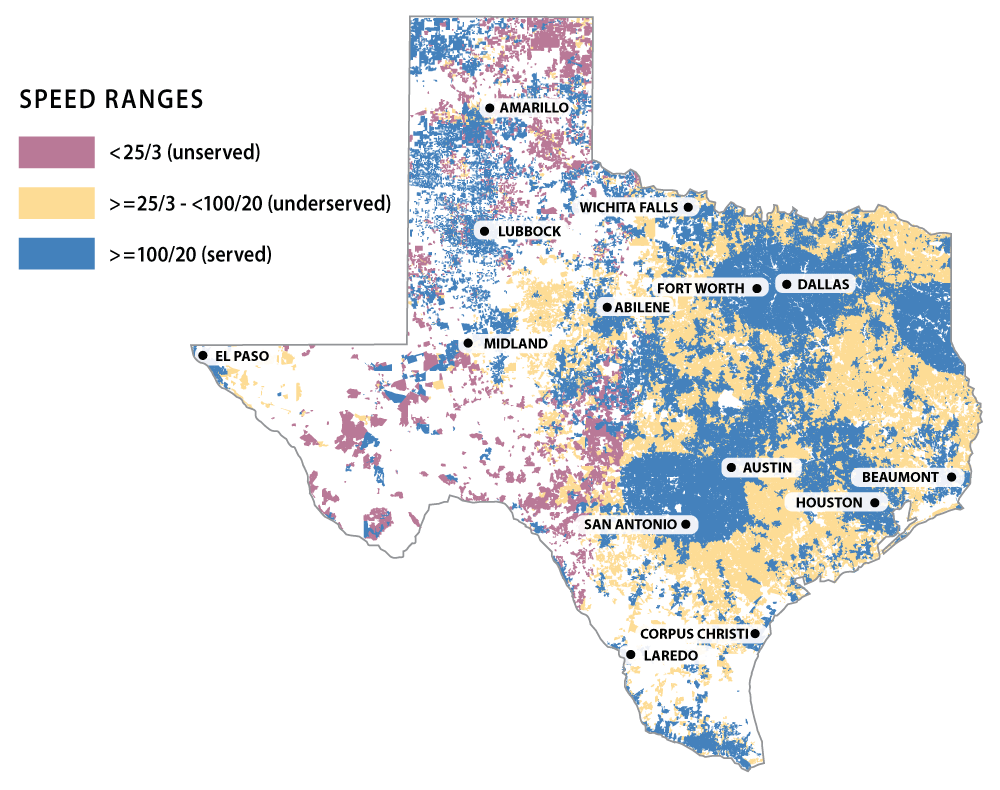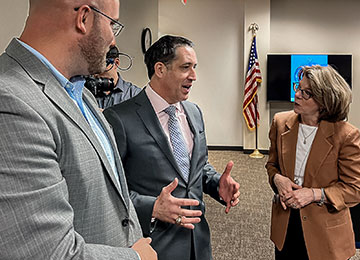Texas Broadband Development Office Charging Ahead Fresh Federal Grant Highlights Broadband Expansion Initiatives

The Comptroller’s Texas Broadband Development Office (BDO) became operational in September 2021 and has been working urgently ever since to help bring high-speed internet to Texas communities.
While still a relatively new office, the BDO has achieved significant milestones, including the development of a comprehensive statewide broadband plan and a broadband availability map of Texas. The BDO also has secured funding — including $363.8 million in federal money for its Bringing Online Opportunities to Texas (BOOT) program — to fulfill its legislative directive to connect every Texan to broadband service. There’s still a long road ahead, but with all it has accomplished thus far, the BDO has demonstrated determination to ensure Texas is connected for continued economic and social success.
STATEWIDE BROADBAND PLAN
Texas has more than 30 million residents, and the latest data show almost 7 million of those — representing about 2.8 million households — do not have access to high-speed broadband services. In spring 2022, Comptroller Glenn Hegar and BDO staff conducted a Broadband Listening Tour in 12 Texas communities, covering 5,100 miles; gathering testimony from 209 residents; and receiving 16,241 survey responses regarding broadband access today and how it could improve in the future. Texans’ feedback indicated that slow speeds, unreliable access, cost and coordination are the most critical areas of concern.
The BDO acknowledged these concerns in its 2022 Texas Broadband Plan (PDF), which lays out broadband expansion goals and strategies to achieve them. The plan provides an in-depth analysis of the industries and policy areas that require broadband for continued growth and success, including the following.
Economic Development
For Texas businesses, a broadband connection can boost revenue, expand customer bases and allow entrance into larger vendor networks. This could lead to increased annual sales of $6.7 billion and more than 23,000 new jobs over three years in rural Texas alone.
Education
For kindergarten through graduate school students who want to utilize distance learning programs, broadband is essential. It also allows students to complete homework assignments outside of school and the library.
Health Care
The lack of broadband services in rural communities restricts health care providers from serving rural Texans to the fullest potential. According to the Texas Broadband Plan, broadband would allow remote health care facilities to provide a wide range of cost-effective services including telemedicine appointments and access to medical records via online patient portals.
Agriculture
Modern “precision” farming depends on broadband services to operate certain machinery, irrigation sensors and sales platforms. According to the Broadband Plan, this type of farming may reduce fuel usage by 40 percent, water usage by 20-50 percent and chemical applications (i.e., pesticides) by up to 80 percent.
AVAILABILITY MAP
Broadband is defined as internet that has a minimum speed of 25 megabits per second (Mbps) for downloads and 3 Mbps for uploads — the current standard set by the Federal Communications Commission (FCC). However, many consider speeds of 100 Mbps download and 20 Mbps upload as the minimum required for modern online participation. There are several different types of broadband technology that come with a range of download and upload speeds, including digital subscriber line or DSL, cable modem, fiber, wireless and satellite. The variation in broadband transmission speeds determines how a residence or place of business is grouped: served, underserved or unserved by high-speed broadband.
Understanding which communities fit into those broadband connectivity groups, as defined by state statute, helped the BDO create the Texas Broadband Development Map released in January (Exhibit 1). The map’s broadband availability information shows which addresses in the state have service based on data submitted by internet service providers derived using advertised speed data, which often exceed actual speeds provided to addresses. All broadband service delivery technologies are included on the map, and to avoid overstating coverage, the BDO provides an opportunity for broadband service providers and political subdivisions to petition the office to make changes to the map. However, data used as evidence to counter potential inaccuracies and inflated claims of coverage are often proprietary and difficult to acquire.
EXHIBIT 1: Texas Broadband Development Map

Note: Map is current as of Oct. 7, 2022.
Source: Texas Broadband Development Office
BDO FUNDING
Government funding for broadband development comes from a variety of state and federal sources (Exhibit 2). For starters, the 87th Texas Legislature appropriated $5 million to the BDO for the 2022-23 biennium to implement legislation on broadband expansion, which included developing the statewide broadband plan and broadband development map.
EXHIBIT 2: Texas Broadband Development Funding Sources (in millions)
| Funding Received | Prospective Funding | |||
|---|---|---|---|---|
| Funding Type | State General Revenue | American Rescue Plan– Coronavirus Capital Projects Fund |
Infrastructure Investment and Jobs Act (IIJA)–Broadband Equity, Access, and Deployment Program | IIJA–The Digital Equity Act |
| Total Federal Allocations | $9,800 | $42,500 | $2,750 | |
| Texas Allocations | ||||
| Dedicated Funds | $5.0 | $500.5* | $100.0 (minimum) | |
| Prospective Funds | To be determined | To be determined | ||
*Includes $363.8 million from the BOOT program.
Source: Texas Broadband Development Office
In 2021, the federal government allocated $500.5 million to Texas from the Coronavirus Capital Projects Fund (CPF), a component of the larger American Rescue Plan Act passed by Congress in March 2021. Administered by the U.S. Department of the Treasury, program guidelines state that funds should be used for broadband infrastructure, digital connectivity technology projects and multipurpose community projects. The guidelines also require the funds be expended by Dec. 31, 2026.

Comptroller Glenn Hegar discusses broadband internet access during his visit to the Capital Area Council of Governments in March 2022 while on the Broadband Listening Tour.
The BDO this year won approval to receive $363.8 million (73 percent of its CPF allocation) for the aforementioned BOOT program, which aims to provide broadband service to 152,000 locations throughout Texas. The BDO plans to disburse CPF funding through the competitive BOOT program and begin accepting applications in spring 2023.
Texas is expected to receive a minimum of $100 million dollars for broadband expansion from the federal Broadband Equity, Access, and Deployment (BEAD) Program, a component of the Infrastructure Investment and Jobs Act (IIJA) passed by Congress in November 2021; the final amount, however, likely will be much more. Additional funding is contingent on the FCC’s National Broadband Map and could amount to billions of dollars for broadband expansion, which should be announced as early as this summer.
In November 2022, the FCC released its National Broadband Map that displays high-speed internet availability by location and allows stakeholders, including individuals and state and local governments, to submit challenges to the map’s accuracy. BEAD funding amounts will be announced in June 2023 and will be determined by the number of unserved locations represented in the FCC broadband map after inaccuracies have been identified and addressed.
“My office worked with stakeholders and local governments around the state to establish the best possible avenues for challenging broad inaccuracies through the bulk challenge process,” says Hegar in regard to the FCC broadband map. “We filed a bulk challenge for over 175,000 locations, but it is still critical that individual Texans also engage in the challenge process to ensure the maps are as accurate as possible and funds are fairly allocated to areas that lack service.”
In order to draw down BEAD funds, Texas must participate in the Digital Equity Act (DEA), which is a component of the IIJA with a total funding pool of $1.5 billion available to eligible states through two grant programs: The State Digital Equity Planning Grant Program and the State Digital Equity Capacity Grant Program. These programs seek to expand affordable access to devices (e.g., smart phones, laptops) and educate individuals about how to navigate digital platforms such as email, video chat, e-commerce, telehealth services and more. Expanding digital opportunities via DEA programs will ensure that every Texan has the digital literacy skills and access needed to reap the benefits of reliable broadband service.
But before the BDO receives any IIJA funding, it will need to develop plans and roadmaps for how the funding will be implemented. This process will require extensive local coordination and collaboration to create five-year action plans. Because further IIJA funding is dependent on federal review of these plans, distribution of IIJA grant funds likely will not begin until early 2024 at the soonest.
COMMUNITY PLANNING TOOLS
The BDO offers planning tools for communities to assess their needs and prepare applications for funding opportunities, including tips and suggestions about how to:
- Assess community needs and goals.
- Identify community resources and leaders.
- Prepare a successful funding application.
“Local communities, nonprofits and citizens should begin, if they haven’t already, to prepare for the funding,” says BDO Director Greg Conte. “Communities looking to expand broadband access locally to create jobs, improve educational opportunities, promote economic development, spur private investment and facilitate the delivery of essential social services to their citizens will need to get ready by creating a vision, establishing goals, understanding the digital divide in their region, identifying barriers and engaging with providers.”
Conte explains that local government and community leaders are ideally positioned to convene stakeholders, assess needs, determine broadband gaps and leverage assets.
“[Leaders] need to become empowered, and local citizens need to become motivated to accelerate local planning,” Conte says. “The best way the BDO can execute on these funds is if our locals and providers are ready to receive it.”
Texas Connectivity Fund
On the first day of the 2023 legislative session, state Sen. Charles Perry filed Senate Joint Resolution (SJR) 27 and Senate Bill (SB) 377, which propose a constitutional amendment to create the Texas Connectivity Fund. This fund would support the development of broadband and related telecommunication services throughout the state. SJR 27 and SB 377 call for the use of state sales and use taxes on telecommunication services to fund the Texas Connectivity Fund without increasing tax rates.
Source: Texas Legislature Online
MOVING FORWARD
Beyond funding, the BDO recognizes that more can be done to support communities. One of the BDO’s goals is to work with Texas educators to address the connection needs of rural and urban classrooms across the state through teacher roundtables and collaboration with education agencies.
Conte stresses the office’s adherence to transparency and its commitment to an “open door” approach. “The BDO is a place where Texans can voice their broadband needs year-round through surveys, community meetings and social media campaigns,” he says.
The BDO’s monthly newsletter connects Texans to broadband news, funding and expansion updates and upcoming deadlines for federal broadband programs. The January 2023 newsletter was sent to more than 5,600 subscribers.
The BDO will continue pursuing its mission to provide reliable broadband connection to Texans across the state. “This is a monumental task, and we must work together to accomplish it,” Hegar says. “Expanding broadband access will require collaboration and partnerships between local governments and private entities, across counties and among residents.” FN
To receive updates on broadband programs in Texas, subscribe to the BDO’s monthly newsletter. Read our Fiscal Notes archives for more background on the efforts to bring high-speed internet to Texans over the years.

